Plush hotels and even better restaurants make little San Cassiano one of the best ski resorts in Europe for a lush and laid-back holiday. And when you’re done eating and drinking, a vast intermediate-friendly playground beckons – courtesy of the Dolomiti Superski area.
Altitude: 1537m
Lifts: 53
Top lift: 2778m
Ski area: 130km of pistes locally (part of a wider 500km network of interlinked lifts and pistes)
Adult lift pass: €272-339 for six days
Official Site |
Ski Map |
Webcam
It may be home to one of the best restaurants in the Alps, but little San Cassiano is still relatively unknown in the English-speaking ski world. It’s a baffling thought. Because when most of us dream of the perfect ski resort, it’s something close to this: a sunny, upbeat mix of chic hotels, spectacular mountain scenery and uncommonly good food and wine. And so what if the climate is relatively dry and the terrain flattering rather than fearsome? However many cliff jumps we’ve watched on Youtube , most of us don’t spend enough time in the mountains to be able to ski off-piste in thigh-deep powder. What we really want are broad, soothing pistes on which to build our confidence, and just a handful of properly steep descents to test ourselves at the end, when we’re feeling salty.
Thanks to its location, just off the edge of Pralongià plateau, San Cassiano has that kind of terrain by the bucketload. There’s a lot more to be tackled in the other resorts of the Dolomiti Superski area too: around the Sella Ronda and off into the Val Gardena and the Val di Fassa. With some fabulous mountain restaurants sprinkled in between, as well as a regular programme of gastronomic events, it’s a mouthwatering prospect.
There is, however, one important caveat. Most of the skiing on the Pralongià plateau is in the 1800-2000m range, which is low for an Easter trip – unless the weather is unusually chilly. Plan a mid-December to mid-March visit to avoid soft/heavy snow on the lower slopes.
For links to the latest official Covid travel information see here.
A short guide to the skiing at San Cassiano
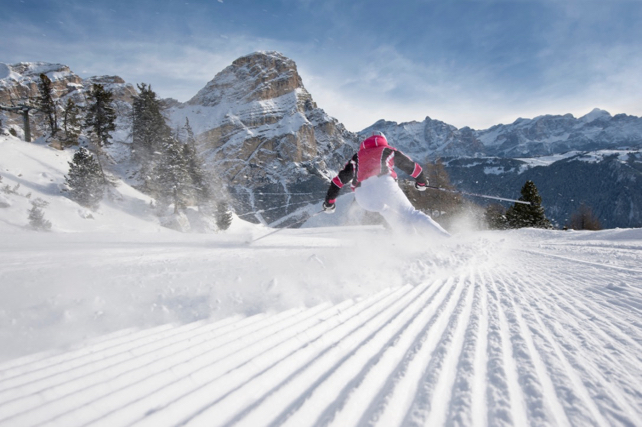
The well-groomed pistes on the plateau above San Cassiano are part of the 130km Alta Badia lift system – and they’re perfect for a mix of gentle cruising and the occasional faster burn. 91% are served by snow cannons, so even if there hasn’t been much natural snowfall they’re usually in good nick too.
Even timid intermediates will be relaxed and comfortable up here, although one of the home runs back to the village is more demanding, especially at the end of the day when it falls into shadow and can turn icy. This the route of the red piste 12 on the Alta Badia ski map. If you’re unnerved by such conditions, take the gentler blue piste 11 back down. But there’s no shame in jumping in the gondola and riding it back to the village.
Once you’ve warmed up on the plateau (and had at least one memorable lunch – see below) it’s time to start exploring – in particular, aiming at the celebrated Sella Ronda circuit. This girdles the fortress-like Sella massif and is one of the world’s great on-piste ski tours, provided you don’t mind the occasional lift queue. During busy periods it can take six hours to get round, so set off early. None of the pistes that make up the circuit is very difficult, though you should have couple of weeks’ skiing under your belt before you try it. From start to finish, the slab-sided Dolomite scenery is spectacular too.
There are tougher challenges here
Not all the skiing near San Cassiano is easy. Chief amongst the challenges is the magnificent Gran Risa race track, which drops from the top of the Piz La Ila lift station, down to the outskirts of La Villa, on on the northern side of the plateau.
Each year, before Christmas, it’s the scene of two fast and furious Giant Slalom races. Here’s how Norwegian Henrik Kristoffersen skied it in 2021.
Obviously it’s much less intimdidating when it’s not covered in snow that’s been injected with water to make it both denser and harder. And you won’t have make turns so sharp your edge angles need to be up near 90 degrees. But it is one of the classic Dolomite blacks, plunging off the edge of the plateau on a cold, north-facing slope, and pulling up sharply at the edge of La Villa. Catch it when the snow’s in good condition, and it’s sheer joy if you’re a confident piste skier: and a waking nightmare if you’re only comfortable on blues.
Other adventures include two local on-piste ski tours. The Lagazuoi Skitour is the more famous, and takes you up to the very edge of Cortina d’Ampezzo’s ski area, and the front line between Italy and Austria during the First World War. It finishes with the strangest ski lift you’re ever likely to take, as you’re dragged back to the Alta Badia village of Armentarola behind a horse-drawn sleigh. The second takes you to the eye-wateringly pretty church at La Crusc.
More confident skiers will also want a crack at the steep pistes above Arabba (a detour off the Sella Ronda), and the famous FIS World Cup course in these parts: the Saslong. This isn’t as steep as the Gran Risa, but it’s another fantastic valley run. Both are part of the 500km network of groomed runs into which San Cassiano is plugged. (The wider Dolomiti Superski area is even larger, but is not all its parts are connected by lifts and pistes – you’ll have to ride some buses too.)
Meanwhile, budding acrobats will have their eye on San Cassiano’s Snowpark, on the Ciampai slope near Piz Sorega.
Where to Stay in San Cassiano
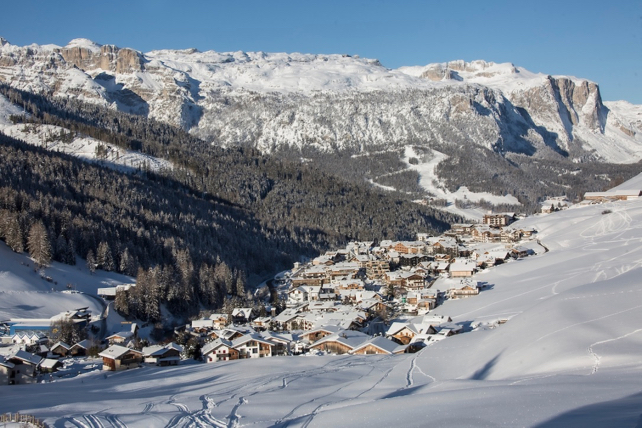
San Cassiano is set just off the mountain road to Cortina d’Ampezzo, beneath the magnificent western face of the Piz dles Conturines. Most of the village is bypassed by the main road, and this is where you want to stay for the best mix of atmosphere and (relative) proximity to the lifts – unless you have your own car of course.
Bear in mind, however, that the Piz Sorega gondola is the only lift up onto the Alta Badia’s slopes, and it’s set at the southern end of the village, on the far side of the river. It’s a bit of hike in ski boots from much of the accommodation, so make your sure your hotel or apartment has its own shuttle bus or is near a public bus stop.
You can also leave your skis and boots in a locker at the Alpine Sports rental centre near the lift.
There’s a broad mix of accommodation on offer – everything from luxury hotels to B&Bs and apartments – and standards are generally high. Many properties have lovely interiors too: with the rich textures of wood, stone and wool much in evidence. Given its modest size it’s one of the most design-conscious resorts we know in Europe.
Top of the tree is the five-star Rosa Alpina whose relentless drive for luxury has done wonders for San Cassiano’s reputation in recent years. Its décor is a little more conservative than some of its rivals, but there’s no doubting the quality of the service or the comfort on offer. Its St Hubertus restaurant has three Michelin stars and is a must-try destination for gastronomes: thanks to chef Norbert Niederkopfler’s focus on local ingredients and inventive, mountain flavours. You wouldn’t want to eat there every night, of course, so it’s good to know the hotel has a more informal wine bar and fondue restaurant as well.
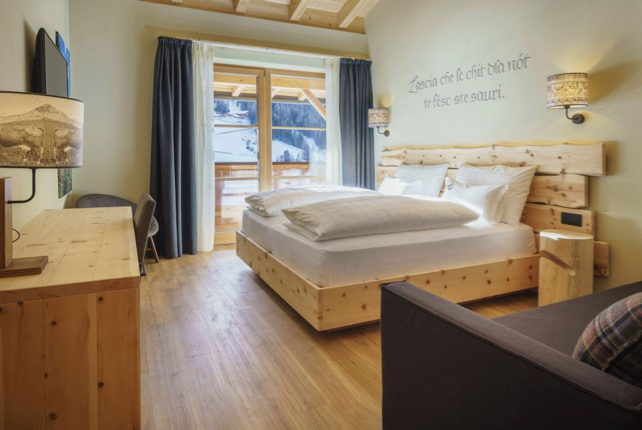
Other treats include the Lagacio Hotel Mountain Residence whose 24 smart apartments feature floor-to-ceiling windows and plenty of local slate, larch and spruce. There is a good spa with sauna, steam bath, bio-sauna, and treatment rooms (try the Alpine Herbal Stamp Massage), as well as a fitness centre. The hotel’s drinking water is provided by the property’s own spring. Like the Rosa Alpina, the Lagacio has its own shuttle bus, as does the recently-refurbished Conturines-Posta. This two has a chic modern interior, in a very restrained range of colours.
You’ll find similar high standards at the Hotel Störes, which features some of the boldest interiors in the village – including a double-height pool room and a wonderful circular fireplace in the lounge. However, the hotel is much closer to the lift (less than five minutes on foot) so doesn’t offer a shuttle bus. Next door The Plang Farmhouse is a farmhouse B&B that mixes Alpine textures and space-age lines – and is wildly popular with guests.
Meanwhile, up on the slopes, La Vegas Lodge maybe called a “hut”: but there’s nothing rudimentary about it. This chic restaurant-cum-lodge, set at 2050m on Piz Sorega, has a Milan-meets-Stockholm style – panelled throughout with wood, and filled with contemporary furniture.
Ski Schools in San Cassiano
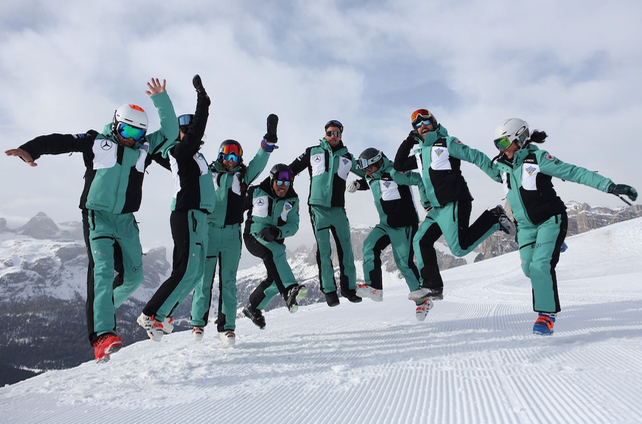
There are two schools with bases by the Piz Sorega lift station at the edge of the village – the San Cassiano ski school and the Dolomites ski school. Both are dab hands at teaching intermediate-level skiers as well as kids, but bear in mind that most of the their clientele are Italians or Germans. So try to join an English-speaking group lesson, or at the very least insist on (and get proof of) that your instructor is a fluent English speaker.
Prices for group lessons are comparable with the rest of the Alps, but as in many Italian resorts, the cost of a private lesson is astonishingly low, compared with the A-list resorts of France. At the San Cassiano ski school, for example, they’re half the price you’d pay with some schools in the likes of Méribel and Courchevel. So treat yourself to the joy of some close personal attention to your technique for at least a couple of hours – and ideally two or three sessions over the course of the week. It should have a transformative effect on your skiing.
A British family specialist is here
Well-heeled British families should bear in mind that family-friendly tour operator, Powder Byrne runs one of its family programmes in San Cassiano. By no stretch of the imagination could a Powder Byrne holiday be called cheap. But then we wouldn’t recommend San Cassiano if you’re budget’s tight anyway. So – if you’ve got the money to burn, and fancy a laid-back, sybaritic trip, with dawn-to-dusk childcare on hand, then give PB’s programme some serious thought. It features exclusive creches and ski school classes for its clients’ children – but the full range of services is only available during February half-term.
The best restaurants in San Cassiano
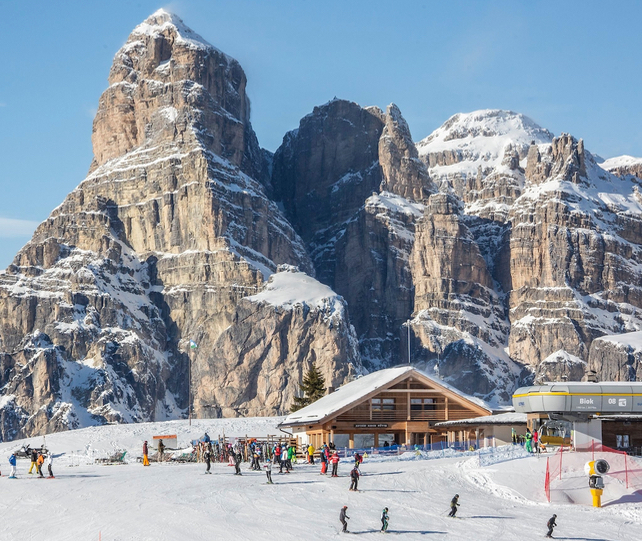
One of skiing’s best resorts for a long lunch
Fancy spending a couple of sun-drenched afternoons relaxing on a restaurant terrace? With sensational scenery to accompany your meal? Then put San Cassiano near the top of your hit list. There are only a handful of resorts (Zermatt, Courmayeur, St Moritz) that can match it.
Occupying the plum spot above the village is Club Moritzino, at Piz la Ila. Forget the pizzeria and snack bar. The only place to eat here is the table-service restaurant, where the speciality is seafood shipped in daily from the Adriatic. Think squid ink pasta, scallop carpaccio and fresh lobster. Lunch on its sun deck, with Metodo Classico sparkling wine fizzing in your glass, is a proper Dolce Vita experience. No wonder it’s a favourite with Italian celebs.
That said, almost every refuge is worth investigating, thanks to the culinary ambitions of the area. The region even runs a collaborative project in which some of the most influential chefs of the regions create dishes for individual mountain huts. At the recently-renovated Rifugio Ütia de Bioch, for example, you can try a lasagne of celeriac puff pastry with venison ragout, created by Simone Cantafio of La Stüa de Michil in Corvara.
Meanwhile, Malga Saraghes, above San Cassiano, serves outstanding homemade pasta, home-made sausage and its own eggs.
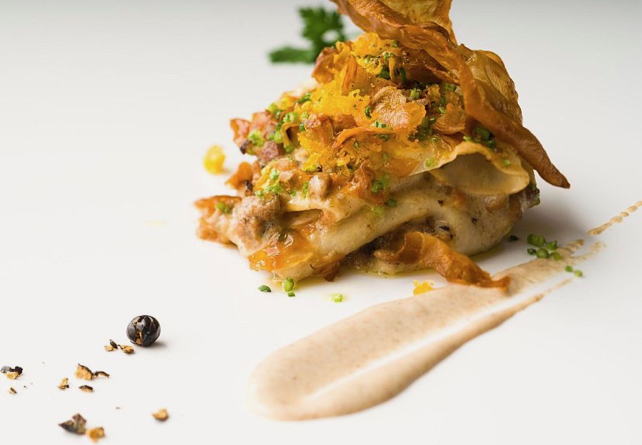
Down in the valley, in the quiet village of Armentarola, the Hotel Ciasa Salares offers sharing plates and light, snacky food with a gastronomic edge, accompanied by weekend DJ sets on its sunny terrace.
One other must-eat destination is Rifugio Scotoni, which is set in the Hidden Valley away from the main area of pistes. It’s a bit of a schlep to get there, but makes for a fun half-day excursion after you’ve got a few days of proper skiing under your belt. Plus the food, and scenery are superb.
Take a bus or cab up to the Passo Falzarego, above Cortina d’Ampezzo, then jump on the cable car to Lagazuoi, and ski the long, rolling and undemanding piste towards the village of Armentarola. Two thirds of the way down, you’ll pass the Rifugio, where you can stuff yourself on the most divine barbecued meat. At the bottom of the piste you can then pay a few euros to hang onto a rope and be pulled back by horses into Armentarola.
Always drink the local wine
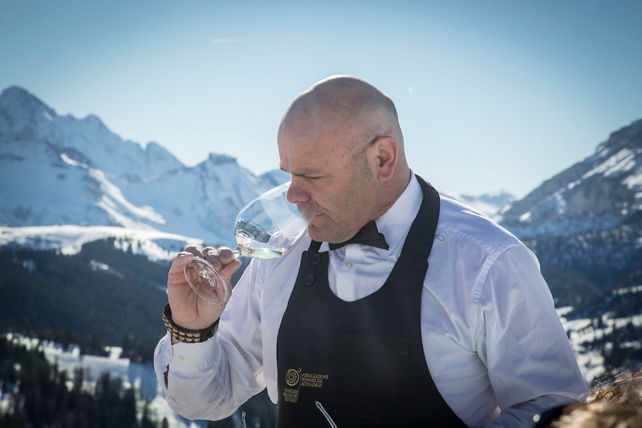
This is not advice we’d usually give in mountain regions: but these are the Dolomites, and the Adige valley, which runs through their western fringes, has both the climate and the soil for wine-making. The results are a revelation. Sparkling and red wines are the real stars here, but there are delicious still whites too: and if you can, try to plan a holiday that coincides with a Sommelier on the Slopes guided tour. Led by a ski instructor and a professional sommelier, you’ll stop at several mountain restaurants en route and taste some of the Südtirol’s most interesting and distinctive wines.
Top notch for dinner, too
A few years ago, I complimented the Hugo Pizzinini – owner of the Hotel Rosa Alpina – on the award of a second Michelin star to its gastronomic St Hubertus restaurant – where Norbert Niederkofler is chef. “That’ll be good for business, then,” I ventured “What?” he spluttered. “You think we make money out of a restaurant like this? We do it for love! If we didn’t, we’d have given up long ago”. Whatever it is that drives Pizzinini and Niederkofler onwards, the results are extraordinary, and since that meeting the restaurant has been awarded a third star. You’ll need to save up hard for one of the Niederkofler’s 13-course Cook the Mountain tasting menus but if you’re going to ski San Cassiano in style, then it’s an essential stop. The wine list, by the way runs to 142 pages.
The Rosa Alpina’s less formal wine bar and grill is good too, but if you’re looking for more Michelin-starred food you need to jump in a cab to Corvara, to the La Stüa de Michil at Hotel La Perla. Meanwhile, in the village of Armentarola, the Hotel Ciasa Salares recently decided to drop out of the Michelin game, and now offers a more relaxed series of dining options – in the wine cellar, in its cheese and chocolate rooms and in the main restaurant.
Après-ski in San Cassiano
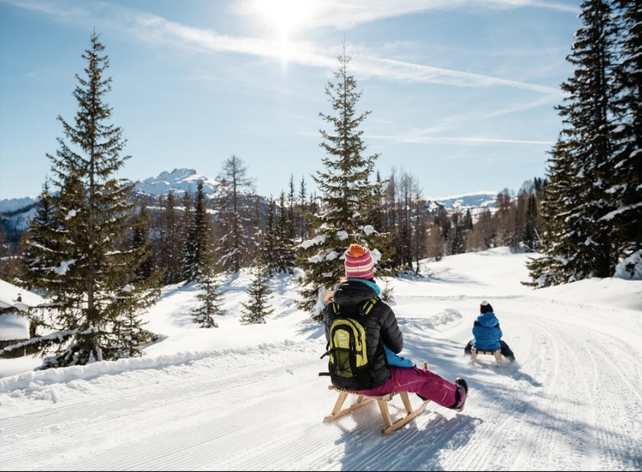
This is a great place for enjoying a hot chocolate and Strudel in one of the tearooms or pastry-shops, relaxing with a grown-up glass of wine in your luxury hotel, or shopping in the pleasant pedestrian area, but it’s less good for dancing on tables in your ski boots.
Children will love the 3.5km tobogganing run from Piz Sorega back into town, too: although you’ll need to go early. The Piz Sorega gondola usually stops running at 4.15pm.
That said, up on the mountain, the hip and contemporary Las Vegas Lodge is a great place to stop for a late-afternoon drink. Meanwhile on the sun deck of the Club Moritzino, there’s a party atmosphere, especially at weekends. Later, down in the valley, there are couple of buzzy, friendly stops on the way back into the San Cassiano: at La Sieia, the former sawmill just below the lift station, and De la Vedla near the pedestrianised village centre. Both offer excellent pizzas, so a quick drink could easily become an all-nighter.










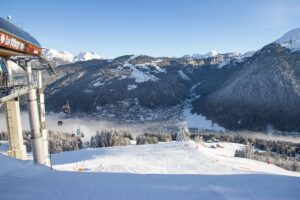
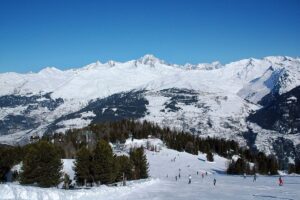
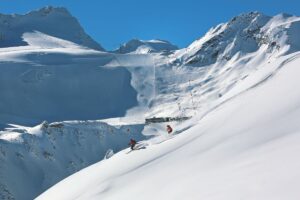
When in San Cassiano a “Hidden Valley” run from the top of Lagazuoi is a must even though you have to take a local bus to get to the starting point !